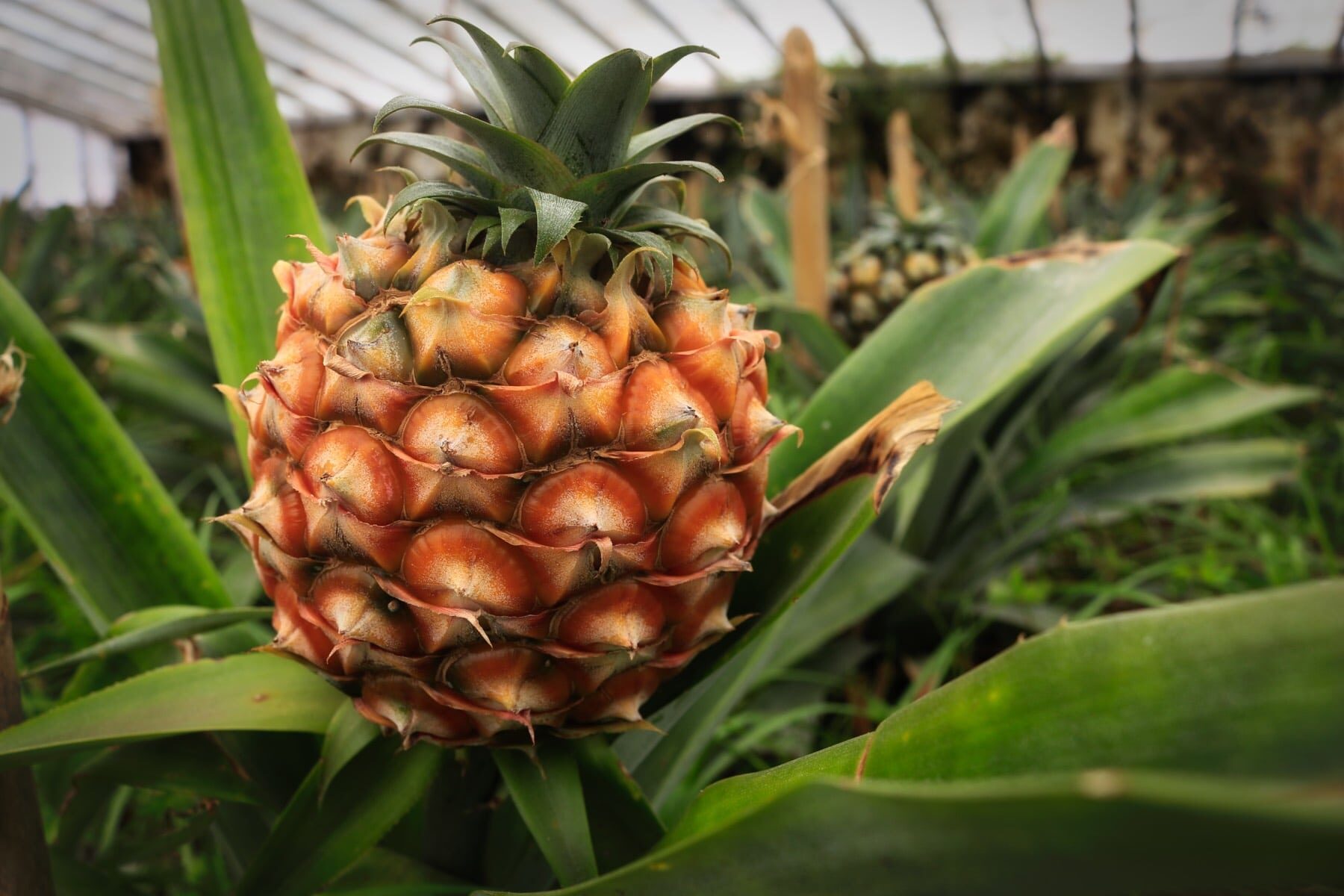Ananás dos Açores
A história do Ananás dos Açores é bastante interessante e teve início no século XIX, na Ilha de São Miguel.
Os portugueses descobriram a fruta na época da colonização do Brasil e a trouxeram-na até ao Arquipélago dos Açores, sendo cultivada em estufa e tratada como uma planta ornamental de experimento cultural e curiosidade botânica. Só mais tarde souberam que o ananás era uma fruta saborosa e de forte valor comercial.

Fotografia de ByAçores
Em 1864, foi construída a primeira estufa de característica industrial, com capacidade para 800 plantas. A evolução foi tanta que pouco tempo depois a Ilha de São Miguel já contava com 4.300 estufas de produção, começando assim as primeiras exportações de ananás.
Já no começo do século XX, o Ananás dos Açores, internacionalmente conhecido, passou a ser exportado para países como Inglaterra, Alemanha e Rússia.
Após mais de um século de comercialização na Europa, uma importante conquista para o Ananás dos Açores chegou em 1996, quando a Denominação de Origem Ananás dos Açores/S. Miguel foi registada e protegida pela Comissão Europeia por meio do Regulamento (CE) nº 1107/96, no dia 12 de junho.
Atualmente, a maior parte da sua produção ocorre na cidade de Ponta Delgada.
Índice de conteúdos
Plantação do Ananás dos Açores
O Ananás dos Açores é produzido em estufas de vidro, com a utilização de técnicas de cultivo tradicionais, sendo aplicado “fumo” e utilizada “cama quente” à base de matéria vegetal.
É importante que essa terra denominada “cama quente” seja rica em matéria orgânica, para garantir a qualidade dos ananases. Apenas um fruto é produzido para cada planta de ananás.

Fotografia de Cristina Pinto
No primeiro mês de produção, a plantação precisa ser regada em abundância e, no decorrer dos outros meses, essa irrigação é reduzida até que seja totalmente retirada na fase conhecida como maturação, onde ocorrem alterações acentuadas nos aspectos físicos e químicos dos ananases.
A aplicação do “fumo” acontece depois de quatro meses e tem como finalidade a queima de verduras dentro das estufas, para que as plantas possam florescer todas na mesma velocidade, mantendo assim o controle de toda a produção.
Todo este processo de produção do Ananás dos Açores leva cerca de dois anos, contando desde a plantação até o momento em que o fruto está apto para a realização da colheita.

Fotografia de Ana Fragata
Curiosidades
O ananás é um fruto de forma cilíndrica, com coroa pequena a média, polpa amarela, casca laranja, teor elevado de açúcar, acidez moderada e possui aroma agradável. Nas estufas de vidro, é possível ver os estágios de crescimento dos ananases e conhecer um pouco mais sobre o seu processo de produção.
Outra curiosidade é que os ananases possuem valor nutritivo, como vitamina C, A, B1, potássio, magnésio, manganês, cobre, ferro, fibras e bromelina, além de regular a atividade muscular do coração. Vale destacar que a casca do ananás também possui nutrientes e pode ser aproveitada na preparação de sumos e chás.
Visitar plantação de ananases

(C) elchicogris
Se visitar a Ilha de São Miguel não deixe de conhecer o Ananás dos Açores, fazendo uma visita às estufas presentes na ilha, entre elas:
Ananases A Arruda
Morada
Rua Doutor Augusto Arruda Fajã de Baixo
9500-454 Ponta Delgada
Horário
Entrada Gratuita / Aberto todos os dias
Abril a Setembro das 09:00 às 20:00
Outubro a Março das 09:00 às 18:00
Ananás Santo António
Morada
Rua José Manuel Bernardo Cabral nº 1
9500-450 Ponta Delgada
Horário
Entrada Gratuita
Aberto todos os dias das 09:00 às 18:00
Plantação de Ananás dos Açores
Morada
Rua das Laranjeiras
9500-317 Ponta Delgada
Horário
Aberto todos os dias das 09:00 às 18:00
É uma ótima actividade para quem quer aprender um pouco mais a respeito desta deliciosa fruta, conhecer de perto todo o seu processo: desde a plantação inicial até à sua colheita e comercialização, assim como degustar produtos derivados do ananás, como compotas, licores entre outros – que estão igualmente disponíveis para venda ao público.
Dica: Não deixe de provar a iguaria regional de morcela com Ananás dos Açores.

- 🔒 Seguro de viagem com 15% desconto para os Açores ou outro destino Clique aqui para simular >
- 🛫 Procura viagens para os Açores? Veja estas promoções >
- 🚘 Alugar viatura nos Açores? As melhores rent-a-car >
- 🧗🏼♂️ Actividades e Experiências durante a sua estadia? Confira aqui >
- 🐳 Ver Baleias e Golfinhos? Reserve já online >
- ❌ Teve um Voo Cancelado ou Atrasado nos últimos 3 anos? Receba aqui a sua compensação >







